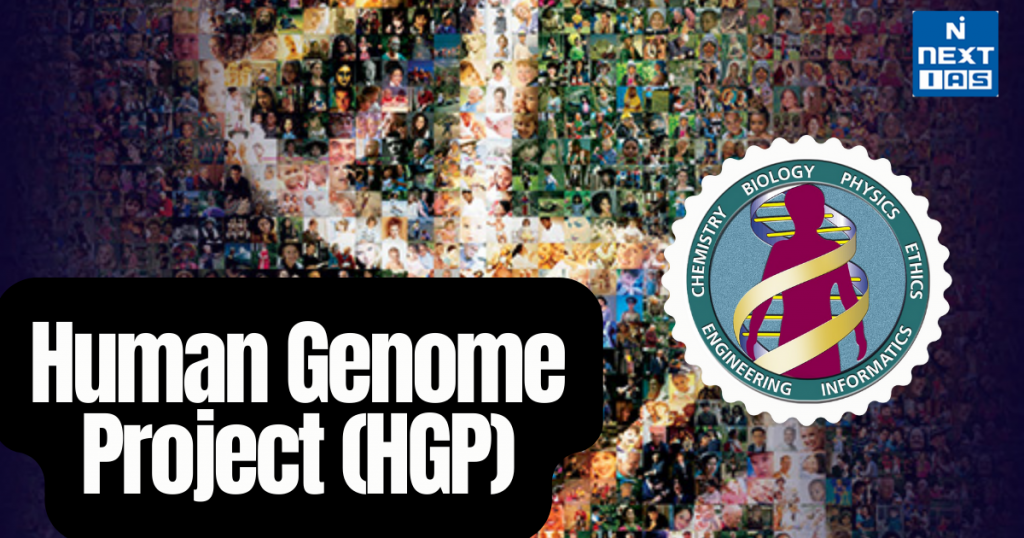
The Human Genome Project (HGP) was an international research initiative that aimed to map and sequence all the genes in human DNA. Its significance lies in its transformative impact on medicine, genetics, and our understanding of human biology, paving the way for disease prevention and treatment advancements. This article aims to study in detail the goals, methodologies, and applications of the Human Genome Project.
About Human Genome Project
- The Human Genome Project (HGP) was an international scientific research project that aimed to determine the complete sequence of the nucleotide bases that make up human DNA and all the genes it contains.
- It remains the world’s largest collaborative biological project.
- The US government first proposed the idea in 1984. Planning began in 1990, and the project was formally launched in 1990 and declared complete in 2003.
Goals of Human Genome Project
The goals of Human Genome Project can be seen as follows:
- To identify and map all the 20,000.25,000 genes in the human DNA from a physical and functional standpoint.
- To determine the sequences of the billion chemical base pairs that make up the human DNA.
- To store this information in databases.
- To discover more efficient technologies for data analysis.
- Allow the private sector access to the information and technologies that arise from this project.
- Sequencing the genomes of other vital organisms in medical research, such as mice and Drosophila, is also essential.
- To address ethical, legal and social issues.
Participating countries and funding agencies
- In 1990, the US Department of Energy (DOE) and the National Institute of Health were two major funding agencies.
- They developed an MoU to coordinate plans and set the clock for initiating the Project.
- Most government-sponsored sequencing was performed in universities and research centers in the United States, the United Kingdom, and Japan. France. Germany. Canada and China.
- A parallel project, formally launched in 1998, was conducted outside the government sponsorship by the corn corporation or Cetera Genomics.
- The Human Genome Project, initiated in 1990, was a publicly funded project that aimed to determine the DNA sequence of the entire euchromatic human genome within 15 years.
Pioneers in Human Genome Project
- Robert Glosheimer proposed the idea of Human genome sequencing in 1983.
- HGP Act was passed in the US Congress under President Regan in 1988
- James Watson headed the NIH Genome Program.
- Francis Collins succeeded James Watson in 1993 as the overall Project Head and Director of the NI El (which later became the National Human Genome Research Institute NIIGRI) and remained in power until the completion of HGP in 2003.
- Determining the human genome first involves genome mapping or characterising the chromosomes. This is called a genetic map.
- The next step is DNA sequencing, which determines the order of DNA bases on a chromosome. These are piratical maps.
Sequencing Strategies in Human Genome Project
To sequence DNA, it must first be amplified or increased in quantity. There are two types of DNA amplifications:
- Cloning: Cloning refers to making identical copies of a specific DNA fragment or gene. Molecular cloning is commonly used to isolate, replicate, and manipulate DNA sequences for research and biotechnology purposes.
- It involves inserting a DNA fragment into a vector (e.g., a plasmid) to create a recombinant DNA molecule, which can then be propagated in host cells.
- Polymerase Chain Reactions (PCR): Polymerase Chain Reaction (PCR) is a widely used molecular biology technique that amplifies a specific DNA sequence, generating millions of copies of a target DNA segment.
- PCR is essential in various fields, including genetics, genomics, forensics, and clinical diagnostics.
- Kary Mullis first developed it in the 1980s, and has since revolutionised molecular biology research.
Now that the DNA has been amplified, sequencing can begin. Sequencing techniques used in HGP are:
- Shotgun sequencing method: Shotgun sequencing is a DNA sequencing method used to determine the sequence of an entire genome, large DNA fragments, or even an entire DNA library.
- It is a powerful and widely used approach in genomics and was an essential technique employed during the Human Genome Project (HGP).
- Shotgun sequencing does not rely on prior knowledge of the DNA sequence.
- Instead, it involves breaking a long DNA molecule into numerous smaller fragments, sequencing those fragments, and then reassembling the sequence from the resulting shorter reads.
- Sianger sequencing method: Sianger sequencing is based on the principle of DNA replication in vitro using dideoxynucleotide triphosphates (ddNTPs).
- Unlike normal nucleotides (dNTPs) with a hydroxyl group (-OH) at the 3’ end of the deoxyribose sugar, ddNTPs lack this hydroxyl group.
- When a ddNTP is incorporated into a growing DNA strand during replication, it terminates further extension because the absence of the 3’ -OH group prevents the addition of the next nucleotide.
- After proper sequencing, mapping can be done using various data analytical tools.
Applications of Human Genome Project
Some current and potential applications of Human Genome Project include
- Molecular medicine
- Improved diagnosis of disease
- Earlier detection of genetic predispositions to disease
- Rational drug design
- Gene therapy and control systems for drugs
- Risk assessment
- Assess health damage and risks caused by radiation exposure, including low-dose exposures.
- Assess health damage and risks caused by exposure to mutagenic chemicals and cancer-causing toxins.
- Reduce the likelihood of heritable mutations.
- Bioarchaeology, anthropology, evolution, and human migration
- Study evolution through germline mutations in lineages.
- Study migration of different population groups based on female genetic inheritance.
- Study mutations on the Y chromosome to trace the 1lineage and migration of males.
- Compare breakpoints in the evolution of mutations with ages of populations and historical events.
- DNA forensics (identification)
- Identify potential suspects whose DNA may match evidence left at crime scenes
- Exonerate persons wrongly accused of crimes
- Identify crime and catastrophe victims
- Establish paternity and other family relationships
- Identify endangered and protected species as an aid to wildlife officials (could be used for prosecuting poachers)
- Detect bacteria and other organisms that may pollute air, water, soil, and food
- Match organ donors with recipients in transplant programs
- Determine pedigree for seed or livestock breed
- Authenticate consumables such as caviar and wine
Conclusion
In conclusion, the Human Genome Project has profoundly influenced various scientific disciplines, enhancing our understanding of human health and genetics. The insights gained from this project continue to drive research and innovation, promising further breakthroughs that will shape the future of medicine and biology.
FAQs
What are the main points of the Human Genome Project?
The Human Genome Project (HGP) mapped the entire human DNA sequence, identifying all genes and their functions. It advanced medical research, disease diagnosis, and personalized medicine. HGP improved biotechnology, forensic science, and evolutionary studies. Completed in 2003, it revolutionized genetics, enabling breakthroughs in gene therapy and biomedical innovations.
Who launched the Human Genome Project?
The Human Genome Project (HGP) was launched in 1990 by the U.S. Department of Energy (DOE) and the National Institutes of Health (NIH). It was an international collaboration involving researchers from the USA, UK, Japan, France, Germany, and China. The project aimed to map and sequence the entire human genome.
Who is the father of the human genome?
Gregor Mendel is considered the “father of genetics” for his foundational work on inheritance. However, in the context of the Human Genome, James Watson played a key role in advocating for the Human Genome Project (HGP), while Francis Collins led the project to its successful completion in 2003.
What is the 10000 Indian genome project?
The 10,000 Indian Genome Project aims to sequence the genomes of 10,000 individuals across India to study genetic diversity, disease susceptibility, and population-specific traits. Led by CSIR, it supports precision medicine, biotechnology, and healthcare advancements by providing insights into India’s vast genetic heritage for better diagnosis and treatment strategies.
Why is the human genome project important ?
The Human Genome Project (HGP) is crucial for understanding genetic diseases, enabling personalized medicine, and advancing biotechnology. It helps identify disease-causing genes, improves drug development, and enhances forensic science. HGP also provides insights into evolution and human ancestry, revolutionizing healthcare, genetics research, and biological sciences for global benefit.
What is the human genome project all about ?
The Human Genome Project (HGP) was an international research effort (1990–2003) to map and sequence all human DNA. It identified genes, their functions, and genetic variations. HGP revolutionized medicine, enabling disease diagnosis, gene therapy, and personalized treatments while advancing biotechnology, evolutionary studies, and forensic science for global scientific progress.
What are the advantages of the human genome project ?
The Human Genome Project (HGP) offers numerous advantages, including improved disease diagnosis, personalized medicine, and gene therapy advancements. It enhances drug development, forensic science, and evolutionary research. HGP also aids in understanding genetic disorders, enabling targeted treatments, while fostering biotechnology innovations for healthcare, agriculture, and environmental sustainability.
What is the human genome project?
The Human Genome Project (HGP) was an international research initiative (1990–2003) aimed at mapping and sequencing the entire human genome. It identified genes, genetic variations, and their functions, revolutionizing medicine, biotechnology, and genetics. HGP enabled breakthroughs in disease diagnosis, personalized medicine, gene therapy, and evolutionary research.
Why is the human genome project called a mega project ?
The Human Genome Project (HGP) is called a mega project due to its large-scale international collaboration, vast funding, and advanced technology. It involved sequencing 3 billion DNA base pairs, requiring global scientific expertise. HGP revolutionized medicine, genetics, and biotechnology, making it one of the most ambitious biological projects ever undertaken.






